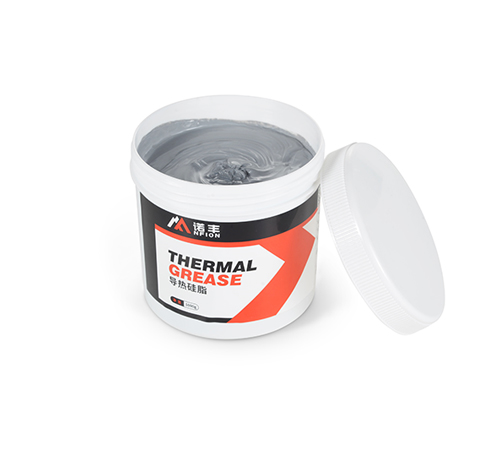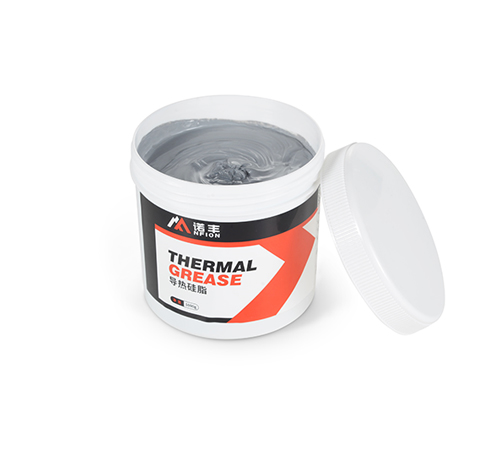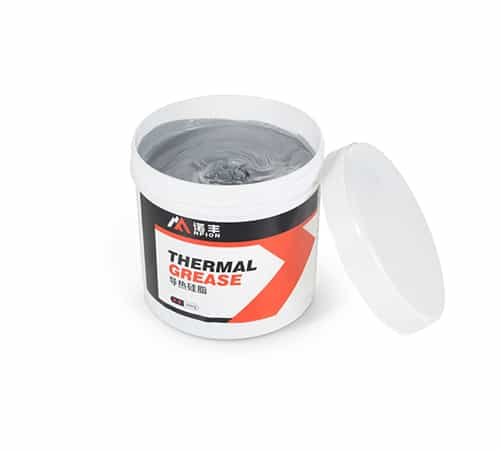
In the realm of electronic devices and heat dissipation systems, thermal grease plays an indispensable role. Its primary function is to fill minute gaps between heat-generating components and heat sinks, enhancing thermal conductivity efficiency, thereby ensuring the normal operation and stability of devices. Among its critical performance indicators is temperature resistance, leading us to the question: just how high a temperature can thermal grease withstand? This is the topic we delve into today.
Basic Composition and Principles of Thermal Grease
Thermal grease primarily consists of silicone oil and thermally conductive fillers. Silicone oil provides excellent wetting and fluidity, guaranteeing sufficient filling of tiny gaps between heat sources and cooling fins. Thermally conductive fillers, such as aluminum oxide and boron nitride, are key to achieving high-efficiency heat transfer.
Its working principle revolves around gap filling to minimize air presence, thereby reducing thermal resistance and facilitating faster, smoother heat transfer.
Key Factors Affecting the Temperature Resistance of Thermal Grease
(1) Properties of Silicone Oil
Different silicone oils exhibit varying degrees of thermal stability and temperature resistance ranges. High-quality silicone oils maintain a stable chemical structure at higher temperatures, whereas lower quality ones may degrade or oxidize at relatively lower temperatures.
(2) Type and Ratio of Thermally Conductive Fillers
As mentioned, the choice of thermally conductive filler directly impacts temperature resistance. Advanced fillers like boron nitride have exceptional temperature resistance. Moreover, the filler ratio influences overall temperature tolerance, with a higher content typically elevating the upper limit.
(3) Role of Additives
Additives are incorporated to improve other properties of thermal grease, including oxidation resistance and corrosion resistance. These additives can also have an impact on temperature resistance.
Common Temperature Resistance Ranges of Thermal Grease
Typically, commercially available thermal greases have a temperature resistance range within a certain interval. Ordinary thermal grease can maintain stable performance within approximately -50℃ to 150℃. However, some high-performance products can tolerate even higher temperatures, up to 200℃ or more.
There can be significant variation in temperature resistance among different brands and models of thermal grease, depending on factors such as formula design and manufacturing processes.
Methods for Assessing Temperature Resistance
(1) Thermogravimetric Analysis (TGA)
By measuring mass loss of thermal grease at various temperatures, TGA reveals its thermal stability and temperature resistance limits.
(2) Differential Scanning Calorimetry (DSC)
DSC detects changes in thermal flow during heating and cooling of thermal grease, analyzing critical information like phase transition temperatures, providing important bases for temperature resistance evaluation.
(3) Long-Term Thermal Aging Tests
Subjecting thermal grease to prolonged high-temperature environments assesses changes in appearance and performance, evaluating its real-world temperature resistance reliability.
Strategies for Enhancing Thermal Grease’s Temperature Resistance
(1) Optimizing Silicone Oil Selection
Carefully selecting silicone oil with high heat resistance ensures stable performance under high temperatures.
(2) Improving Thermally Conductive Fillers
Developing and using more efficient, higher temperature-resistant fillers to elevate overall temperature resistance.
(3) Optimizing Formulation and Processes
Through continuous experimentation and formula improvement, finding the optimal combination ratio of silicone oil, thermally conductive fillers, and additives, while optimizing production processes to ensure product consistency and stability.
Application-Specific Requirements for Thermal Grease’s Temperature Resistance
(1) Electronic Device Cooling
In computers, smartphones, etc., thermal grease must operate stably within the device's normal operating temperature range, usually requiring resistance up to about 150°C.
(2) Industrial Equipment Thermal Management
Equipment in industrial settings often faces harsher high-temperature environments, necessitating more stringent temperature resistance from thermal grease, potentially reaching 200°C or higher.
(3) Automotive Electronics
The high temperatures and harsh conditions within vehicles impose significant demands on thermal grease, requiring temperature resistance that accommodates fluctuations during vehicle operation.
Future Trends in Thermal Grease’s Temperature Resistance
With technological advancements, demands for higher temperature resistance in thermal grease will escalate. Future trends may include:
(1) Application of New Materials
Exploring and applying novel silicone oils, fillers, and additives to achieve superior temperature resistance and comprehensive performance.
(2) Integration of Nanotechnology
Utilizing nanotechnology to produce finer, more efficient thermal grease, boosting its performance at high temperatures.
(3) Multi-Function Integration
Future thermal grease may combine improved thermal conductivity, insulation, anti-aging properties, and more, realizing multifunctional integration.
In conclusion, the temperature resistance of thermal grease is a complex yet crucial consideration. Practitioners must select appropriate thermal grease based on specific application scenarios and requirements. Simultaneously, researchers must strive for innovation and improvement to enhance both the temperature resistance and overall quality of thermal grease. As a content creator in thermal management, I hope this article offers readers a deeper, comprehensive understanding of thermal grease’s temperature resistance, contributing to the ongoing development and progress in thermal management.

 CN >
CN >



